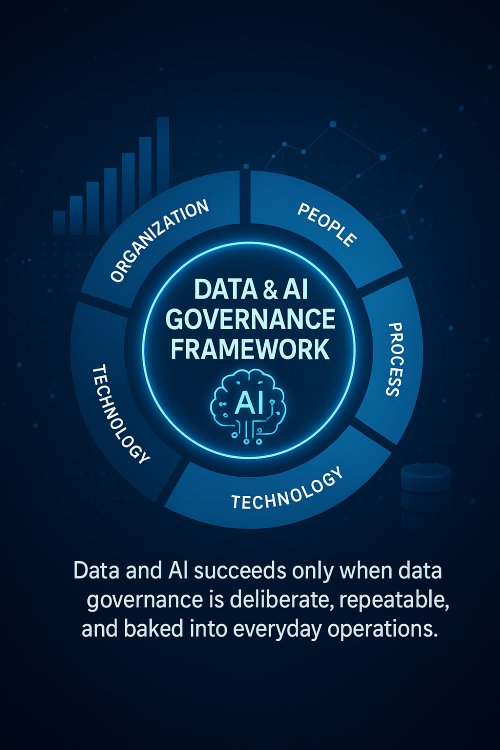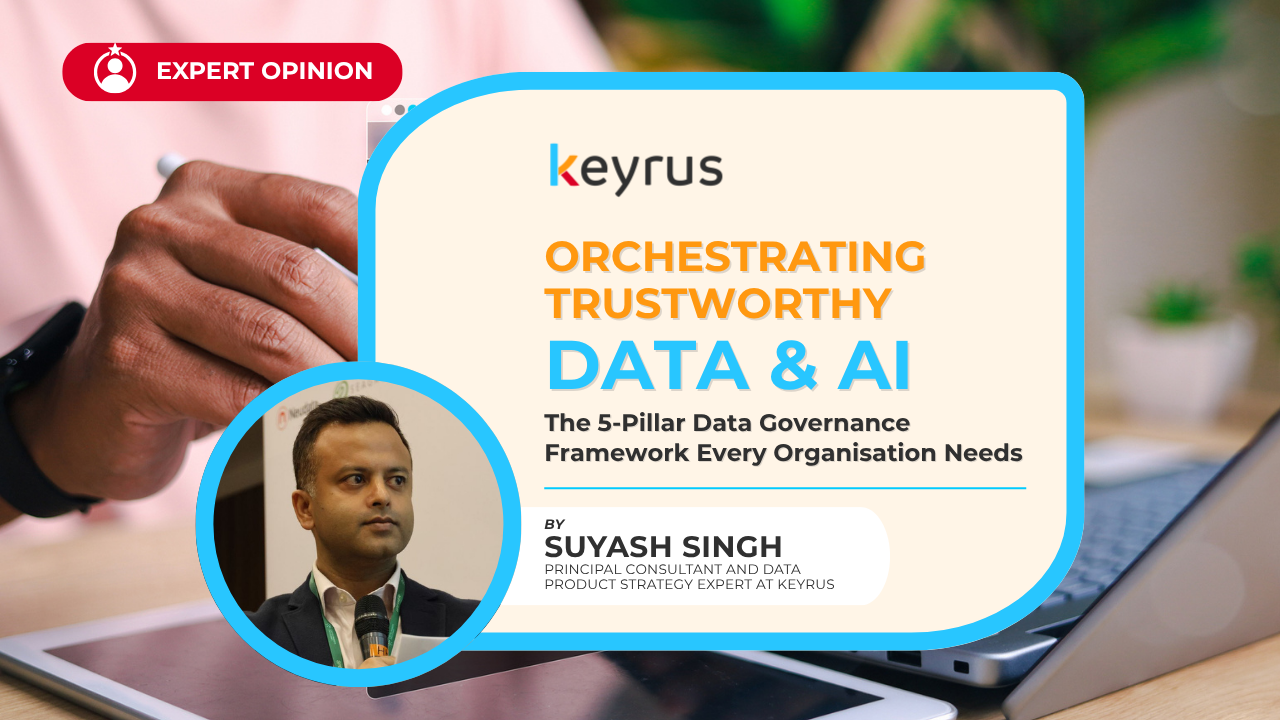Over the past year, my team and I have helped several organisations ranging from U.S. banks and U.K. utilities to Middle Eastern telecom operators prepare the data foundations needed for advanced analytics and AI. Industry and culture changed across these engagements, but one governing principle never did: Data and AI succeed only when data governance is deliberate, repeatable, and baked into everyday operations.
Yet, when I speak with business leaders about data governance, I often see eyes glaze over. The term conjures images of bureaucratic committees and endless documentation that slows innovation to a crawl. This couldn't be further from the truth. In my experience, effective governance accelerates innovation by creating the trustworthy foundations that AI and advanced analytics demand.
Why Data Governance Can't Wait in the AI Era
The stakes have never been higher. Poor data quality costs organisations at least $12.9 million per year on average, says a Gartner report. Even more striking, research shows majority of AI project failures trace back to governance lapses or bad data. Meanwhile, data-mature companies are 23 times more likely to acquire customers and 9 times likelier to retain them, reflecting McKinsey's findings on the competitive advantage of strong data foundations.
The regulatory landscape is also intensifying rapidly. 167 countries now have omnibus data-privacy laws, up from 137 just four years ago, according to UNCTAD. This isn't just a compliance burden—it's a signal that data governance has become a core business competency.
The 5-Pillar Framework: From Theory to Practice

To clarify what "deliberate and repeatable" governance looks like in practice, my team and I have developed a 5-pillar framework. This isn't theoretical—it's field-tested across sectors and adapted to work in any organisational culture. Here's how each pillar addresses critical business questions:
Pillar 1: Organisation - Who Owns the Decision Rights?
The most fundamental question isn't technical—it's organisational. In every successful implementation I've guided, clarity around decision rights made the difference between governance that enables and governance that constrains.
Typical Outputs: RACI matrices, data councils, stewardship charters that define clear accountability structures.
AI-Era Watch-Out: Shadow AI teams bypassing governance create significant risk. I've seen well-intentioned data scientists inadvertently expose sensitive customer information through unsanctioned model experiments. The solution isn't to restrict innovation but to ensure clear escalation paths that keep experimentation both safe and rapid.
Pillar 2: People - Do We Have the Skills and Incentives?
Technology alone never solves governance challenges. The organisations that succeed invest deliberately in their people, aligning skills with responsibilities and incentives with outcomes.
Typical Outputs: Role descriptions that reflect modern data responsibilities, upskilling roadmaps that prepare teams for AI-era challenges, and KPI alignment that rewards good governance practices.
AI-Era Watch-Out: The "citizen-developer" surge is democratising AI capabilities, but it's also creating new risks. I've implemented just-in-time training programs and ethical guidelines that empower business users while maintaining appropriate guardrails.
Pillar 3: Process - How Do We Govern Day-to-Day?
Governance isn't a quarterly committee meeting—it's embedded in daily workflows. The most effective processes I've implemented feel invisible to users while providing comprehensive oversight.
Typical Outputs: Data lifecycle SOPs, issue-management workflows, and MLOps checkpoints that ensure models remain trustworthy throughout their deployment lifecycle.
AI-Era Watch-Out: Manual governance processes can't keep pace with automated model retraining. I work with organisations to automate controls inside CI/CD pipelines, ensuring governance scales with innovation velocity.
Pillar 4: Policy - What Rules Keep Us Compliant and Ethical?
Policies provide the ethical and regulatory framework within which innovation operates. The key is making them enabling rather than constraining—clear enough to provide guidance, flexible enough to accommodate innovation.
Typical Outputs: Data classification schemes, retention schedules, and AI ethics principles that translate regulatory requirements into actionable business rules.
AI-Era Watch-Out: Regulatory landscapes are evolving rapidly. I help organisations align with emerging regulations like the EU AI Act, Bahrain PDPL, and UK DPDI while building frameworks that can adapt as requirements evolve.
Pillar 5: Technology - Which Tools Enforce and Monitor?
Technology is the enabler that makes governance scalable and sustainable. The right tools make compliance automatic and provide the visibility leaders need to make informed decisions.
Typical Outputs: Data catalogs, lineage tracking, access management systems, and quality dashboards that provide real-time visibility into data health and usage.
AI-Era Watch-Out: Legacy governance tools weren't designed for modern AI workloads. The platforms I implement must interoperate with vector databases and LLM gateways while maintaining the security and oversight that traditional analytics require.
Common Pain Points and Proven Solutions
Across sectors, I consistently encounter similar challenges. Here are the most common pain points I've solved:
Lack of Understanding of Data Domains and Ownership: Without clear ownership, data becomes everyone's and no one's responsibility. I establish clear stewardship models that balance centralised oversight with distributed accountability.
Duplicate "Golden" Datasets After Cloud Migrations: Cloud migrations often create data sprawl. I've helped organisations reduce duplicate and conflicting datasets by 40%, directly lowering storage, processing, and licensing costs while streamlining operational workflows.
Absence of Clear Data Operating Models: Many organisations have data strategies but lack operational models. I work with leadership teams to define how data flows through their organisation, who makes what decisions, and how success is measured.
Technology-First Approaches: The most common mistake I see is leading with technology rather than people, processes, and policies. Sustainable governance requires human-centered design that makes compliance feel natural rather than burdensome.
Measurable Business Outcomes
The organisations I work with don't implement governance for its own sake—they do it to drive measurable business outcomes:
Enhanced Data-Driven Decision Making: Higher data quality and clearer ownership result in more accurate analytics and AI outputs, supporting better-informed business strategy and investment decisions. One financial services client improved decision accuracy by 35% within six months of implementing our framework.
Accelerated Time-to-Insight: Model validation and deployment timelines have been cut by more than half in successful implementations, enabling business teams to launch new data and AI-driven products or features faster. Speed matters in competitive markets.
Significant Cost Savings: Beyond the 40% reduction in duplicate datasets, clients consistently report lower compliance costs, reduced audit preparation time, and decreased regulatory risk exposure.
Improved Compliance Confidence: Achieving successful data and AI audit sign-offs without expanding team size helps safeguard organisations from regulatory penalties and reputational risk. This confidence enables bolder innovation strategies.
Empowered Innovation: With trustworthy data foundations, business and technical teams focus on value creation and innovation rather than firefighting data issues. This cultural shift often proves more valuable than any specific technical improvement.
The Strategic Imperative
In my experience guiding organisations through digital transformation, data governance has evolved from a nice-to-have to a competitive necessity. The organisations that recognise this early and invest deliberately in governance capabilities consistently outperform those that treat it as an afterthought.
The AI revolution isn't waiting for perfect data foundations, but organisations with strong governance frameworks are capturing disproportionate value from their AI investments. They deploy models faster, with greater confidence, and achieve more reliable business outcomes.
Getting Started: A Practical Approach
If you're plotting an AI roadmap but worry your data house isn't in order, you're not alone. The key is starting with a clear assessment of where you stand today and a pragmatic roadmap for improvement.
I work with organisations to translate governance theory into deployable, value-adding practice without drowning teams in bureaucracy. The most successful implementations begin with pilot programs that demonstrate value quickly, then scale systematically across the organisation.
The framework I've outlined isn't theoretical—it's battle-tested across industries and cultures. Whether you're a U.S. bank preparing for AI-driven risk management, a U.K. utility optimising asset performance, or a Middle Eastern telecom operator personalising customer experiences, the principles remain consistent while the implementation adapts to your context.
The Path Forward
Data governance in the AI era isn't about slowing innovation—it's about enabling sustainable innovation at scale. The organisations that get this right don't just avoid regulatory penalties and data quality issues; they build competitive advantages that compound over time.
Ready to transform your data governance from compliance burden to competitive advantage? The conversation starts with understanding where you are today and where you need to be tomorrow. Every organisation's journey is unique, but the destination—trustworthy data foundations that enable AI-driven growth—is universal.
Suyash Singh is a Principal Consultant and Data Product Strategy Expert at Keyrus UK, specialising in data governance frameworks that enable AI-driven innovation. His 5-pillar approach has helped organisations across sectors build trustworthy data foundations that accelerate rather than constrain digital transformation initiatives.
